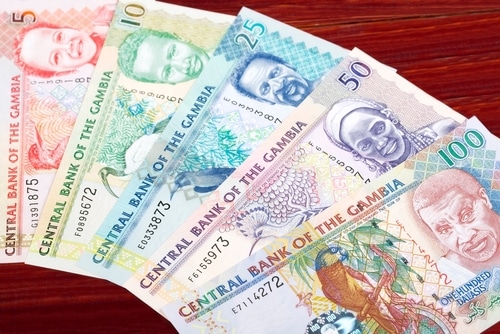From the introduction of coins and banknotes in 1971 to the rise of money transfer apps that make it easy to send money to Africa, Gambia’s currency and economy have changed a lot over the years. Unlike Senegal and some of its other neighbors, Gambia does not use the West African CFA franc. Instead, Gambia’s official currency is the dalasi.
Do you plan to visit the Republic of the Gambia or send money to friends and family there? Here’s what you need to know about the Gambian dalasi.
Denominations of the dalasi
The Central Bank of The Gambia is located in the capital city of Banjul and issues the country’s coins and banknotes. Coins come in six denominations: 1, 5, 10, 25, and 50 bututs, and 1 dalasi. However, steep inflation means that the smaller denominations have little value and haven’t been re-issued since 1998.
Banknotes come in seven denominations: 5, 10, 20, 25, 50, 100, and 200 dalasis. You can find banknotes from several different issues, including a 2015 series featuring former president Yahya Jammeh and an earlier printing dating back to 2006.
The most recent series from 2019 is the “Birds” issue, featuring the giant kingfisher, crowned cranes, and other birds, as well as the Gambia coat of arms.
6 essential facts about Gambia’s currency

Although Gambia’s economy is smaller than many of its neighbors, Gambia currency stands out from other currencies in the Senegambia region.
1. The name might come from the English word “dollar.”
Although there’s some disagreement on where the word “dalasi” comes from, the Merriam-Webster dictionary suggests that it may be derived from “dollar.”
Wolof speakers in West Africa referred to the French 5-franc coin as “dala,” leading linguists to speculate that dalasi comes from the same root.
The meaning of the word butut is more definitive. It comes from the Wolof word for “something small” but wasn’t used to refer to money until 1972.
2. The dalasi replaced the Gambian pound.
Gambia is surrounded by a former French colony, Senegal, that uses the West African CFA franc. But Gambia’s history as a British colony means it retained some influences from the United Kingdom, including the Great British pound (GBP).
Gambia briefly introduced its own version of the pound before switching over to the dalasi in 1971, but it never joined the West African Economic and Monetary Union (WAEMU), and to this day, it maintains its own independent currency.
3. The dalasi is a free-floating currency.
The value of the Gambian dalasi fluctuates depending on the strength of Gambia’s economy and on world currency markets. This means that you won’t always get the same exchange rate when converting 1 USD into Gambian currency.
In contrast, the CFA franc is pegged to the euro (EUR), so you’ll always get the same rate when exchanging between those two currencies.
4. The currency code for the dalasi is GMD.
If you’re looking up the exchange rate for the Gambian dalasi, you’ll want to use the currency code GMD. This allows you to compare the exchange rate for 1 GMD vs. the U.S. dollar, Canadian dollar, New Zealand dollar, and other world currencies.
Simply use an online currency converter or your favorite money transfer app to find the real-time exchange rate.
5. There are 49.41 billion dalasis in all.
The International Monetary Fund (IMF) reports the total amount of GMD in the world at 49.41 billion, of which 19.93 billion are held in foreign currency reserves.
The current GDP of the Republic of the Gambia is around $1.8 billion USD, nearly a third of which comes from the agricultural sector.
6. The U.N. is investing in Gambia’s mobile payments sector.
Gambia is one of five countries participating in a United Nations International Fund for Agricultural Development (IFAD) program to boost mobile remittances.
The program will provide 1.2 million euros over two years, with the goal of increasing access to remittances in rural agricultural communities. Currently, only 3% of global remittances are sent using a mobile transfer service.
A brief history of Gambia currency
To understand the role of the dalasi in the Gambian economy, it’s important to know a little bit about the history of the region. According to the RIMA International Journal of Historical Studies, “the British colonial government monetized Gambia’s economy” in 1912 when it created the West African Currency Board (WACB).
Similar to other cultures in West Africa, the people of the Gambia had a barter economy based on items such as “cowrie shells, manilas, salt, [and] pieces of cloth.” The British government brought the British pound with them, replacing this traditional system.
When the country gained its independence in 1965, it replaced the British West African pound with the Gambian pound, but retained the same denominations: 20 shillings to a pound and 12 pence to a shilling.
The introduction of the dalasi in 1971 transformed the economy once again—this time into a decimal currency, with 1 dalasi consisting of 100 bututs. During this transitional period, one Gambian pound equaled 5 dalasis.
Converting and using the dalasi
Gambia’s economy is cash-based, so if you’re traveling to Gambia, you’ll likely need to carry cash and exchange money as you go. Vendors near the border with Senegal may accept CFA francs, and some businesses that cater to tourists may accept credit cards or debit cards, but it’s best to pay with dalasi.
Most international arrivals land at Banjul International Airport, although there are roads and ferries connecting the capital with other destinations in the region. You’ll have the most options for exchanging money or accessing ATMs along the coast.
Tourism makes up a growing part of Gambia’s economy, with the majority of visitors coming from the U.K.
Visitors come to see the region’s wildlife—specifically its avian diversity—and to visit the village depicted in Alex Haley’s novel Roots. The International Roots Festival is especially popular with the West African diaspora, and takes place twice a year in the village of Juffureh.

